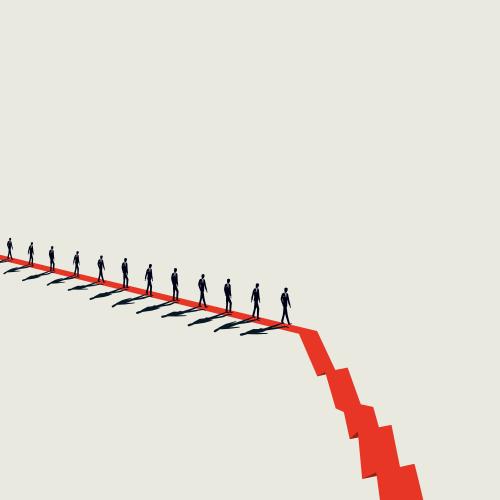If you want more content like this, subscribe to our newsletter.
This week in Class Notes:
- Friendship ties across socioeconomic lines strongly predict upward income mobility.
- The motherhood pay penalty narrows as children age, but a fatherhood premium keeps the gender gap large.
- Half the Black-white gap in unemployment insurance receipt results from state-level rules.
- This week’s top chart shows that counties with high levels of pollution exposure have lower rates of upward mobility.
- Stephen Mihm argues that given the lessons of history, we should be worried about the state of the economy in this month’s op-ed.
- Check out our new piece on the effect of job displacements on short- and long-term earnings.
- For your calendar: Virtual events on new model estimates for poverty in schools, the semi-annual Brookings Papers on Economic Activity, and evaluation of the long-term effects of universal preschool.
Friendship ties across socioeconomic lines strongly predict upward income mobility
Social capital consists of relationships and networks, that can often lend us the resources to achieve important goals such as employment, housing, or education. Social capital is usually difficult to measure because of data limitations, but Raj Chetty and his colleagues were able to analyze 21 billion friendships from Facebook to understand the role of social capital in social mobility. They find that economic connectedness (EC), defined as the extent of friendship ties across socioeconomic status (SES), is a very powerful predictors of upward income mobility. If children from low-SES families had the same level of economic connectedness as the average child with a high-SES family growing up, their incomes in adulthood would increase by 20% on average. This increase in income would close around 37% of the current gap in adult income between children who grew up in the 25th and 75th percentile of the income distribution. For more information, check out our blog summary and event discussing this work.
The motherhood pay penalty narrows as children age, but a fatherhood premium keeps the gender gap large
It is a stylized fact that women earn less than men, in large part because mothers typically work less. But what happens to women’s earnings and the gap as children grow up? Claudia Goldin, Sari Pekkala Kerr, and Claudia Olivetti study earnings trends for less-educated and higher-educated groups using longitudinal data from the NLSY79. Paid work hours initially plummet among mothers, especially for college-educated women, and rebound as the youngest child begins school and eventually exits high school. But mothers still lag well behind fathers, in part because fathers typically benefit from an earnings bump. For instance, college-educated women aged 35-39 with children earn 12 log points less than women of the same age without children (motherhood gap), but earn 54 log points less than fathers (parental gap). The fatherhood premium accounts for 40% of the parental gender gap in earnings for college graduates, and it increases with age. For non-college graduates, the fatherhood premium accounts for 25% of a smaller parental gender gap.
Half the Black-white gap in unemployment insurance receipt results from state-level rules
The U.S. unemployment insurance (UI) system is a nationwide social insurance program that is administered at the state level. As a federal-state partnership, state rules and administration of the program can differ, leading to various outcomes—including racial inequality. Using the Benefits Accuracy Management (BAM) audits data, Daphné Skandalis, Ioana Marinescu, and Maxim N. Massenkoff find that about 10% of the gap in Black and white UI receipt is due to work history: Black claimants typically have lower earnings which can make them ineligible for benefits. However, about half of the Black-white gap in UI receipt is explained by differences in state rules, such as minimum earnings eligibility thresholds. This is an example, the authors conclude of how “ostensibly race neutral policies can generate large racial disparities.”
Top chart: Higher exposure to pollution negatively impacts upward mobility
This figure shows prenatal exposure to PM2.5 (particulate matter) and rates of upward mobility (in terms of the relationship between the income ranks of parents and their children at age 30). There is a strong a county-level correlation, and the authors note that exposure to pollution is one of the top five predictors of upward mobility.
 Source: Colmer, Voorheis, and Williams (2022)
Source: Colmer, Voorheis, and Williams (2022)
Choice opinion: Think recession fears are overblown? You need to read this
“The economy of 2022 is quite different from the one in place in the twilight of the Nixon administration. But reliving the confusion of that earlier era is instructive. Any recession or recovery is often attended by confusing, even contradictory data. Put unforeseen inflation, sour sentiment and unexpectedly strong job growth into the mix, and things get messy,” writes Stephen Mihm.
Self-promotion: Job displacements have large and persistent negative effects on earnings due to a decline in wages
Job displacements occur when a worker involuntarily loses a full-time job that they have held for at least two years. A new report by our colleagues Ariel Gelrud Shiro and Kristin Butcher shows that the impacts of these displacements are large and persistent. Workers experience a 57% decline in annual earnings the year after displacement and continue to earn 25% less compared to non-displaced individuals 10 years after the shock. This negative persistence is largely driven by a decline in wages and not by a decline in the likelihood of being employed or in hours worked. Unemployment insurance and expanded earned income tax credits can potentially buffer the negative earnings losses for displaced workers.
For your calendar: Virtual events on new model estimates for poverty in schools, BPEA, and evaluation of the long-term effects of universal preschool
Using model estimates of poverty in schools
Urban Institute
Thursday, August 25, 2022 3:00 PM – 4:00 PM EDT
Brookings Papers on Economic Activity (BPEA) Fall 2022 Conference
Brookings Institution
September 8-9, 2022
The long-term effects of universal preschool in Boston
Federal Reserve Bank of Boston
Thursday, September 15, 2022 1:45 PM – 3:00 PM EDT
The Brookings Institution is committed to quality, independence, and impact.
We are supported by a diverse array of funders. In line with our values and policies, each Brookings publication represents the sole views of its author(s).









Commentary
Class notes: Friendships and upward mobility, racial gaps in UI receipt, and more
August 19, 2022